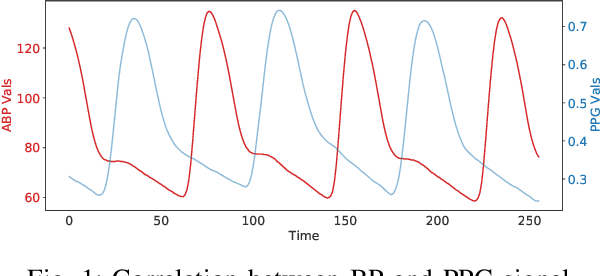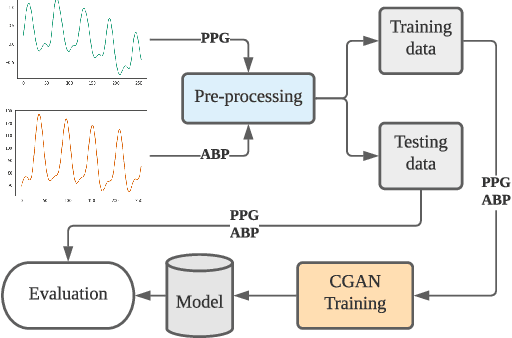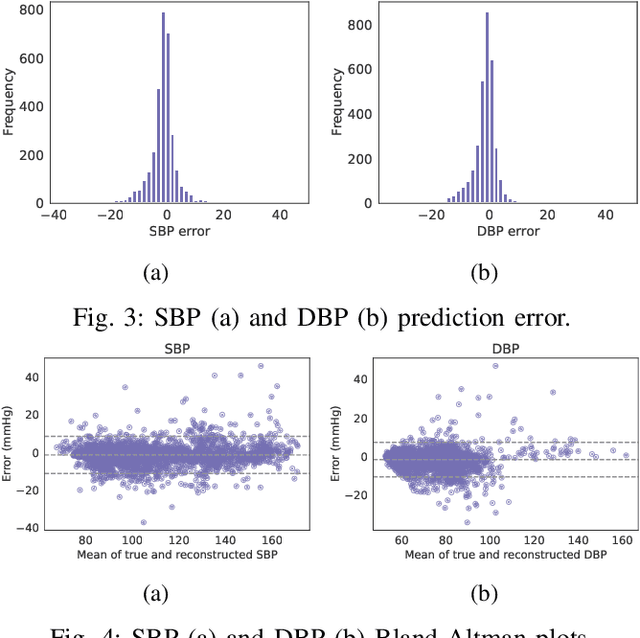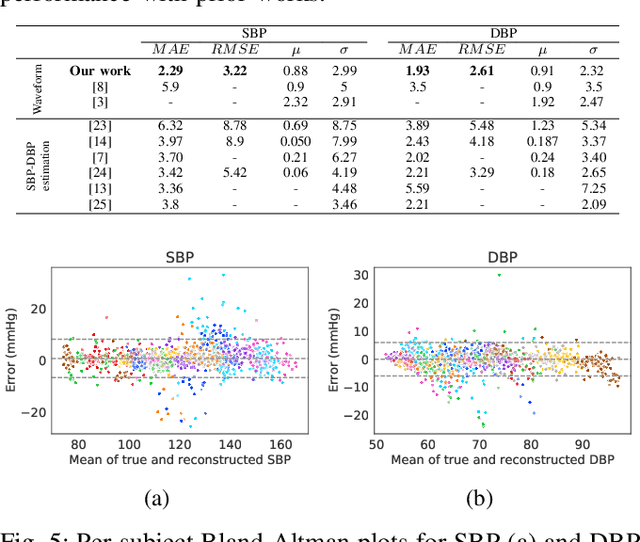Amir Hosein Afandizadeh Zargari
Novel Blood Pressure Waveform Reconstruction from Photoplethysmography using Cycle Generative Adversarial Networks
Jan 24, 2022



Abstract:Continuous monitoring of blood pressure (BP)can help individuals manage their chronic diseases such as hypertension, requiring non-invasive measurement methods in free-living conditions. Recent approaches fuse Photoplethysmograph (PPG) and electrocardiographic (ECG) signals using different machine and deep learning approaches to non-invasively estimate BP; however, they fail to reconstruct the complete signal, leading to less accurate models. In this paper, we propose a cycle generative adversarial network (CycleGAN) based approach to extract a BP signal known as ambulatory blood pressure (ABP) from a clean PPG signal. Our approach uses a cycle generative adversarial network that extends theGAN architecture for domain translation, and outperforms state-of-the-art approaches by up to 2x in BP estimation.
An Accurate Non-accelerometer-based PPG Motion Artifact Removal Technique using CycleGAN
Jun 22, 2021



Abstract:A photoplethysmography (PPG) is an uncomplicated and inexpensive optical technique widely used in the healthcare domain to extract valuable health-related information, e.g., heart rate variability, blood pressure, and respiration rate. PPG signals can easily be collected continuously and remotely using portable wearable devices. However, these measuring devices are vulnerable to motion artifacts caused by daily life activities. The most common ways to eliminate motion artifacts use extra accelerometer sensors, which suffer from two limitations: i) high power consumption and ii) the need to integrate an accelerometer sensor in a wearable device (which is not required in certain wearables). This paper proposes a low-power non-accelerometer-based PPG motion artifacts removal method outperforming the accuracy of the existing methods. We use Cycle Generative Adversarial Network to reconstruct clean PPG signals from noisy PPG signals. Our novel machine-learning-based technique achieves 9.5 times improvement in motion artifact removal compared to the state-of-the-art without using extra sensors such as an accelerometer.
An End-to-End and Accurate PPG-based Respiratory Rate Estimation Approach Using Cycle Generative Adversarial Networks
May 03, 2021


Abstract:Respiratory rate (RR) is a clinical sign representing ventilation. An abnormal change in RR is often the first sign of health deterioration as the body attempts to maintain oxygen delivery to its tissues. There has been a growing interest in remotely monitoring of RR in everyday settings which has made photoplethysmography (PPG) monitoring wearable devices an attractive choice. PPG signals are useful sources for RR extraction due to the presence of respiration-induced modulations in them. The existing PPG-based RR estimation methods mainly rely on hand-crafted rules and manual parameters tuning. An end-to-end deep learning approach was recently proposed, however, despite its automatic nature, the performance of this method is not ideal using the real world data. In this paper, we present an end-to-end and accurate pipeline for RR estimation using Cycle Generative Adversarial Networks (CycleGAN) to reconstruct respiratory signals from raw PPG signals. Our results demonstrate a higher RR estimation accuracy of up to 2$\times$ (mean absolute error of 1.9$\pm$0.3 using five fold cross validation) compared to the state-of-th-art using a identical publicly available dataset. Our results suggest that CycleGAN can be a valuable method for RR estimation from raw PPG signals.
 Add to Chrome
Add to Chrome Add to Firefox
Add to Firefox Add to Edge
Add to Edge